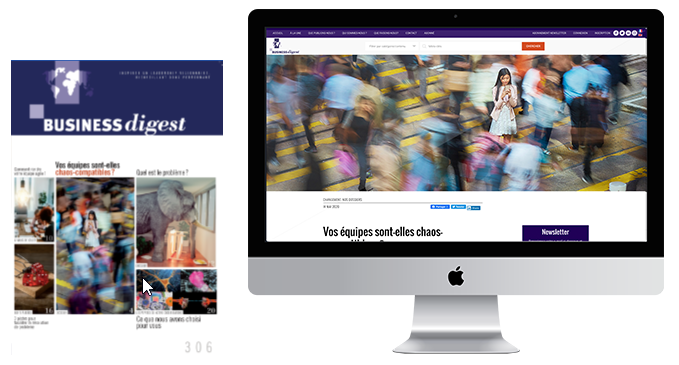L’ensemble des contenus Business Digest est exclusivement réservé à nos abonnés.
Nous vous remercions de ne pas les partager.

Evolutions in work relations will have a moderate impact on the economy
True
False
Right !
In its first report on the “Future of work” (2016), the World Economic Forum presented a shocking figure: more than 5 million jobs could be eliminated in the world’s 15 major economic powers by 2020 (source: Les Echos, 18/01/2016). The most optimistic analysts find solace in the fact that history has been punctuated by episodes of "creative destruction", with job cuts in one industry creating new openings in another. It is a message they are keen to drive home, and it is an assessment shared by Denis Pennel, managing director of the International Confederation of Private Employment Services. Pennel predicts that we will see the emergence of a type of small-series manufacturing that targets customized goods and services. This will be accompanied by a new class of workers / entrepreneurs. Other researchers, however, have a less positive outlook, including the philosopher Bernard Stiegler, who fears widespread proletarianization. Two different visions but one shared conviction: companies are going to have to adapt to new labor patterns. This view is confirmed in a similar observation from the OECD at Davos (2016): “More than automation, it is the risk of replacing employees by independent workers that is likely to have the most impact.”
Wrong !
In its first report on the “Future of work” (2016), the World Economic Forum presented a shocking figure: more than 5 million jobs could be eliminated in the world’s 15 major economic powers by 2020 (source: Les Echos, 18/01/2016). The most optimistic analysts find solace in the fact that history has been punctuated by episodes of "creative destruction", with job cuts in one industry creating new openings in another. It is a message they are keen to drive home, and it is an assessment shared by Denis Pennel, managing director of the International Confederation of Private Employment Services. Pennel predicts that we will see the emergence of a type of small-series manufacturing that targets customized goods and services. This will be accompanied by a new class of workers / entrepreneurs. Other researchers, however, have a less positive outlook, including the philosopher Bernard Stiegler, who fears widespread proletarianization. Two different visions but one shared conviction: companies are going to have to adapt to new labor patterns. This view is confirmed in a similar observation from the OECD at Davos (2016): “More than automation, it is the risk of replacing employees by independent workers that is likely to have the most impact.”
The work in which work will not be “revolutionized.”
True
False
Right !
If there is one thing we can all agree on, it’s that the world of work is changing. There are 5 main forces driving this revitalization of work: new behaviors, technologies, younger generations, mobility and globalization. But one of the most important underlying factors driving this transformation is a shift in who decides how the work is done. Employees are now beginning to take control of decision-making and conversations around work is done, when, with whom, with which technologies, and so on.
Source: “The Future of Work: Attract New Talent, Build Better Leaders, and Create a Competitive Organization,” by Jacob Morgan, Wiley 2014.
Source: “The Future of Work: Attract New Talent, Build Better Leaders, and Create a Competitive Organization,” by Jacob Morgan, Wiley 2014.
Wrong !
If there is one thing we can all agree on, it’s that the world of work is changing. There are 5 main forces driving this revitalization of work: new behaviors, technologies, younger generations, mobility and globalization. But one of the most important underlying factors driving this transformation is a shift in who decides how the work is done. Employees are now beginning to take control of decision-making and conversations around work is done, when, with whom, with which technologies, and so on.
Source: “The Future of Work: Attract New Talent, Build Better Leaders, and Create a Competitive Organization,” by Jacob Morgan, Wiley 2014.
Source: “The Future of Work: Attract New Talent, Build Better Leaders, and Create a Competitive Organization,” by Jacob Morgan, Wiley 2014.
Autonmy within your teams increases collective performance.
True
False
Right !
Project mode is now commonplace along with a profound shift in management functions, with yesterday’s "bosses" taking on new tasks: support, feedback and action points. But companies are going to move even further away from this model of traditional management. Several firms, such as the software developer Sogilis, are already putting their faith in work cells with self-managing teams that define their own goals and recruitment. Certain other companies are opting for flat hierarchies and management based on trust and accountability. This is the case for businesses that subscribe to the holacratic model and other “liberated” companies such as Zappos, Castorama, Auchan, and Poult (a French biscuit manufacturer).
Wrong !
Project mode is now commonplace along with a profound shift in management functions, with yesterday’s "bosses" taking on new tasks: support, feedback and action points. But companies are going to move even further away from this model of traditional management. Several firms, such as the software developer Sogilis, are already putting their faith in work cells with self-managing teams that define their own goals and recruitment. Certain other companies are opting for flat hierarchies and management based on trust and accountability. This is the case for businesses that subscribe to the holacratic model and other “liberated” companies such as Zappos, Castorama, Auchan, and Poult (a French biscuit manufacturer).
The emotional engagement of your staff has little impact on collective performance.
True
False
Right !
The satisfaction of the needs of every individual – his or her thirst for self-expression and recognition — is the order of the day. Society now believes that the talents of each individual should be recognized, and business is following suit, betting on the emotional commitment of staff to raise productivity. Reconsidering the work space, changing the relationship to time, turning companies into wellness spaces – these are not artifacts but rather fundamental transformations to better align individual aspirations to professional environments and ultimately reinforce collective performance.
Wrong !
The satisfaction of the needs of every individual – his or her thirst for self-expression and recognition — is the order of the day. Society now believes that the talents of each individual should be recognized, and business is following suit, betting on the emotional commitment of staff to raise productivity. Reconsidering the work space, changing the relationship to time, turning companies into wellness spaces – these are not artifacts but rather fundamental transformations to better align individual aspirations to professional environments and ultimately reinforce collective performance.
Annual performance reviews can drive engagement.
True
False
Right !
For many actors, current assessment practices no longer meet the needs of companies and their employees, who want feedback as an ongoing activity. The notorious annual performance review is a thing of the past at Accenture, as is true for 1-in-10 Fortune 500 companies. Assessment now instead often takes the form of ongoing appraisal based on almost instant feedback from your line manager (recorded on an open online tool). Other players, under heavy pressure to adapt and change, are being even more proactive, and encourage peer reviewing. As Instagram or Facebook fans are well aware, the « likes » received from family and friends act as a powerful engagement driver. There are several initiatives that are keen to transpose this model to the world of business. The idea is to take things a stage further than the 360-degree interview, which is now widespread, by giving peers responsibility for the entire individual assessment processes and even all or some of the remuneration. At Forbes, for example, bonuses are assigned by colleagues.
Wrong !
For many actors, current assessment practices no longer meet the needs of companies and their employees, who want feedback as an ongoing activity. The notorious annual performance review is a thing of the past at Accenture, as is true for 1-in-10 Fortune 500 companies. Assessment now instead often takes the form of ongoing appraisal based on almost instant feedback from your line manager (recorded on an open online tool). Other players, under heavy pressure to adapt and change, are being even more proactive, and encourage peer reviewing. As Instagram or Facebook fans are well aware, the « likes » received from family and friends act as a powerful engagement driver. There are several initiatives that are keen to transpose this model to the world of business. The idea is to take things a stage further than the 360-degree interview, which is now widespread, by giving peers responsibility for the entire individual assessment processes and even all or some of the remuneration. At Forbes, for example, bonuses are assigned by colleagues.
Today, winning teams are made up of both employees and clients
True
False
Right !
The sociologist Marie-Anne Dujarier argues that the consumer-customer is poised to become "a worker like any other” with simple productive tasks gradually being transferred to the client and the rise of crowdsourcing and crowdsourcing techniques. The extended enterprise is up and running, even if it means sometimes muddying the waters of labor law. This last aspect is of paramount importance in the world of participatory economics. For some companies, intermediation platforms are becoming major business suppliers without, however, taking on any responsibilities for working conditions and social rights. The frequent protests by digital workers using Mechanical Turk, the Amazon crowdsourcing platform, suggest that the legal status quo cannot last much longer.
Source: Business Digest
Source: Business Digest
Wrong !
The sociologist Marie-Anne Dujarier argues that the consumer-customer is poised to become "a worker like any other” with simple productive tasks gradually being transferred to the client and the rise of crowdsourcing and crowdsourcing techniques. The extended enterprise is up and running, even if it means sometimes muddying the waters of labor law. This last aspect is of paramount importance in the world of participatory economics. For some companies, intermediation platforms are becoming major business suppliers without, however, taking on any responsibilities for working conditions and social rights. The frequent protests by digital workers using Mechanical Turk, the Amazon crowdsourcing platform, suggest that the legal status quo cannot last much longer.
Source: Business Digest
Source: Business Digest
Today, winning teams are made up of both human and digital players
True
False
Right !
True. Since the IBM computer Deep Blue beat reigning chess world champion Garry Kasparov in 1997, the general perception is that computers outperform humans in the game of chess. But, in fact, the strongest chess players in the world today are human-computer teams. Brynjolfsson and McAfee quote Kasparov’s description of the results of a 2005 “freestyle” contest, open to any combination of human and digital players: “The teams of human-plus-machine dominated even the strongest computers. The chess machine Hydra, which is a chess supercomputer like Deep Blue, was no match for a strong human player using a relatively weak laptop. Human strategic guidance combined with the tactical acuity of a computer was overwhelming,” says Kasparov. “The surprise came at the conclusion of the event. The winner was revealed not to be a grandmaster with a state-of-the-art PC but a pair of amateur American chess players using three computers at the same time. Their skill at manipulating and ‘coaching’ their computers to look very deeply into positions effectively counteracted the superior chess understanding of their grandmaster opponents and the greater computational power of other participants. Weak human + machine + better process was superior to a strong computer alone and, more remarkably, superior to a strong human + machine + inferior process.”
Source: Business Digest
Source: Business Digest
Wrong !
True. Since the IBM computer Deep Blue beat reigning chess world champion Garry Kasparov in 1997, the general perception is that computers outperform humans in the game of chess. But, in fact, the strongest chess players in the world today are human-computer teams. Brynjolfsson and McAfee quote Kasparov’s description of the results of a 2005 “freestyle” contest, open to any combination of human and digital players: “The teams of human-plus-machine dominated even the strongest computers. The chess machine Hydra, which is a chess supercomputer like Deep Blue, was no match for a strong human player using a relatively weak laptop. Human strategic guidance combined with the tactical acuity of a computer was overwhelming,” says Kasparov. “The surprise came at the conclusion of the event. The winner was revealed not to be a grandmaster with a state-of-the-art PC but a pair of amateur American chess players using three computers at the same time. Their skill at manipulating and ‘coaching’ their computers to look very deeply into positions effectively counteracted the superior chess understanding of their grandmaster opponents and the greater computational power of other participants. Weak human + machine + better process was superior to a strong computer alone and, more remarkably, superior to a strong human + machine + inferior process.”
Source: Business Digest
Source: Business Digest
Today, your performance depends more on your influence than your instructions.
True
False
Right !
Jacob Morgan believes that the days when executives and managers implemented work rules unilaterally are long gone.1 Employees, freelancers and partners are increasingly dictating their own practices, ideas, values and expectations (requirements regarding cooperation, transparency, independence, fair remuneration, and so on). Against this background, what is the main challenge facing decision-makers? Reinventing their style of leadership. The formal authority automatically acquired with age and promotion is no longer enough to mobilize the troops, especially when those troops are not tied to the company as paid employees. In addition, leaders need to draw on new levers of influence, such as trust, a shared vision and goodwill. According to Jon Husband, although hierarchy won’t disappear anytime soon, it’s necessary to recognize the emergence of a new structure: the “wirearchy” or “connectarchy.” Now it’s up to you to reflect on what that means!
Source: ”The Future of Work: Attract New Talent, Build Better Leaders, and Create a Competitive Organization,” by Jacob Morgan, Wiley 2014
And « Wirearchie: Esquisses pour un futur du travai »l, by Jon Husband, Boostzone Editions 2015.
Source: ”The Future of Work: Attract New Talent, Build Better Leaders, and Create a Competitive Organization,” by Jacob Morgan, Wiley 2014
And « Wirearchie: Esquisses pour un futur du travai »l, by Jon Husband, Boostzone Editions 2015.
Wrong !
Jacob Morgan believes that the days when executives and managers implemented work rules unilaterally are long gone.1 Employees, freelancers and partners are increasingly dictating their own practices, ideas, values and expectations (requirements regarding cooperation, transparency, independence, fair remuneration, and so on). Against this background, what is the main challenge facing decision-makers? Reinventing their style of leadership. The formal authority automatically acquired with age and promotion is no longer enough to mobilize the troops, especially when those troops are not tied to the company as paid employees. In addition, leaders need to draw on new levers of influence, such as trust, a shared vision and goodwill. According to Jon Husband, although hierarchy won’t disappear anytime soon, it’s necessary to recognize the emergence of a new structure: the “wirearchy” or “connectarchy.” Now it’s up to you to reflect on what that means!
Source: ”The Future of Work: Attract New Talent, Build Better Leaders, and Create a Competitive Organization,” by Jacob Morgan, Wiley 2014
And « Wirearchie: Esquisses pour un futur du travai »l, by Jon Husband, Boostzone Editions 2015.
Source: ”The Future of Work: Attract New Talent, Build Better Leaders, and Create a Competitive Organization,” by Jacob Morgan, Wiley 2014
And « Wirearchie: Esquisses pour un futur du travai »l, by Jon Husband, Boostzone Editions 2015.
Your results
/ 8



